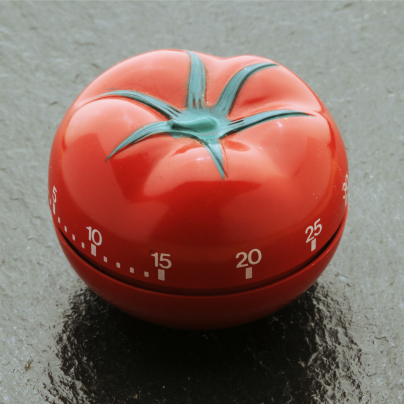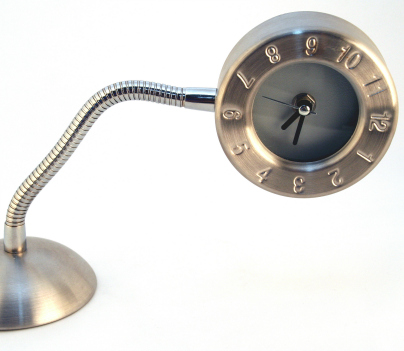(This article is part of the Productivity series. Get free article updates here.)
 Raise your hands if you know exactly what you should do on any given day, but somehow the day slips by before you can knock even half the items off your list…
Raise your hands if you know exactly what you should do on any given day, but somehow the day slips by before you can knock even half the items off your list…
Maybe today was your day to be super productive, but just as you were getting started an important email interrupted you and threw you off the track. Or perhaps, you wanted to just check some news and blogs before getting started, but somehow half the day was gone before you knew it. Or was it one of those days that you actually did get started bright and early, but just as you were getting in the flow, a friend messaged you on Facebook, or Whatsapp, and it was all downhill from there?
Either ways, as you lay your head on the pillow at night, there’s a sick feeling in your stomach. Another day gone by. Another resolve to knock things off your “Get it Done” list failed.
How could you let this happen so often?
We the people of the information generation… we’re both blessed and cursed, don’t you think?
On the one hand, it’s amazing — we have more opportunities to learn, be entertained and stay connected than the generations before us could even imagine.
On the other, it’s downright evil — it creates enough distraction that no man, woman or child without a plan could ever hope to escape.
How do we tame this beast? How can we utilize the beautiful opportunities offered to us by the information age, without being so distracted by it that nothing ever gets done?
Last week we looked at a simplified-GTD system, a series of 4 simple steps that help us tame the overwhelm and determine exactly what we should be doing at any given moment. Today, let’s look at a simple time management technique that helps us actually get that task done!
The Pomodoro Technique for Getting Things Done
It may sound rather fancy, but Pomodoro is actually Italian for tomato. The story of how this technique came about is rather interesting.
 The founder of this technique Francesco Cirillo was in college back in the 80s, battling distraction like most young men and trying to stay on top of his grades. One day, when nothing else seemed to work, he challenged himself to study for just 10 minutes without any distractions. He needed some way to track that time. He ended up using a tomato-shaped kitchen timer that was handy. The rest is history.
The founder of this technique Francesco Cirillo was in college back in the 80s, battling distraction like most young men and trying to stay on top of his grades. One day, when nothing else seemed to work, he challenged himself to study for just 10 minutes without any distractions. He needed some way to track that time. He ended up using a tomato-shaped kitchen timer that was handy. The rest is history.
The simple technique Francesco Cirillo came up with back then, and tweaked over the years, has gained quite a following from around the world. Using a simple timer, this technique offers an effective system to ward off distraction and procrastination, to actually get some work done.
Let’s take a quick look at the simple approach –
The Pomodoro Technique in 6 Simple Steps
The parts in bold are the actual steps from the original Pomodoro Technique. The text next to it has some additional explanation and notes about how I use it.
1. Pick a task that needs to be done. I use this technique in conjunction with the simplified-GTD system from last week. So I pick either a task out of my today’s actions list or the meta-task of sorting through the collections bin.
Note that both GTD and Pomodoro technique strictly forbid multi-tasking (which by the way has been shown through abundant research to not really work.) So, while it’s OK to pick multiple tasks to work on, it is important to finish one before moving on to the next.
2. Set a timer for 25 minutes. The official pomodoro technique requires you to work strictly in chunks of 25 minutes. I personally don’t stick to the 25-minute guideline. In the mornings when I’m feeling fresh and am alone by myself, I find that going for 45-60 minute chunks helps me be the most productive. In the evenings when I’m tired, my daughter is home and distractions are in general higher, I work in much shorter chunks of 10-15 minutes.
You can track time using a standard kitchen timer or one of the many free apps available. Once you get the hang of it, you can also eyeball the time from the little clock on the bottom right corner of your screen, which is what I do.
3. Work on the task until the timer runs out. It is a lot easier to stay away from distraction when you know it’s for just 25 minutes, and you get a guilt-free break at the end of each pomodoro (as the time chunk is called). If anything comes up during the pomodoro, I just add it to my collections bin to be handled later as we discussed in last week’s simplified-GTD system.
4. Put a check mark on paper when the timer runs out.
 At the end of the pomodoro, track your success using a check mark on a paper. If you are using a strict pomodoro of 25 minutes, at the end of the day, tallying up the check marks tells you exactly how productive you’ve been. If you keep a record log, you can find your average productivity, and set a goal each day to beat your average. Overall, you can make a fun game out of this.
At the end of the pomodoro, track your success using a check mark on a paper. If you are using a strict pomodoro of 25 minutes, at the end of the day, tallying up the check marks tells you exactly how productive you’ve been. If you keep a record log, you can find your average productivity, and set a goal each day to beat your average. Overall, you can make a fun game out of this.
I use a slightly modified version though. Instead of checking off pomodoros, I like striking off the actions on my today’s actions list as I complete them. As I’ve worked with this system, I’ve gotten better at breaking up my tasks into a series of smaller actions so they’re easier to track, complete within one or two pomodoros and strike off. There’s nothing like writing down an action, and then striking it off, for a productivity high… beats even very strong coffee and chocolate, if you ask me 🙂
5. Take a short break. About 5 minutes of break for every pomodoro of work is a good balance. This is a good time to either get up and walk around to get fresh blood flowing into your brain again, or indulge a bit and catch up on whatsapp, Facebook, emails… whatever rocks your boat.
I generally keep two separate browser windows open to make sure the breaks and work do not interfere with each other. One is the ‘work’ window with the different tabs corresponding to different things I need for what I’m working on. The other is my ‘play’ window which has my email, facebook, random browsing etc. This way at the end of the break, I find it a little easier to leave since I don’t really have to “close” the windows. I just leave them open knowing they’ll be waiting for me when I return at the end of the next pomodoro — this creates a lot less resistance in switching from break mode to work mode.
6. Take a longer break every 4 pomodoros. After working for about 4 pomodoros, ie, about 2 hours, take a longer break of about 20-30 minutes. I personally work for around 3 hours or so in the morning before taking 30-60 off for lunch. After lunch, I have just 1 pomodoro for work time and then I move on to domestic stuff like cooking, cleaning, picking up my daughter from school, driving her to activities, homework, play, dinner etc. I generally squeeze in 1 or 2 more pomodoro in the night after my daughter goes to bed, for any pending tasks or random browsing.
That’s it. That’s the Pomodoro Technique in a nutshell.
Here’s Why I Love the Pomodoro Technique
1. It’s very simple. The core idea is that we work in cycles of time chunks dedicated to distraction-free focus followed by time chunks dedicated to guilt-free breaks. All you need is some way to track time. It’s so easy, that I actually find myself using it all the time.
2. It’s extremely effective. The simplicity is very deceptive and masks how wonderfully effective it is. When we see a huge task in front of us, psychologically, we tend to drag our feet. Without quite realizing it, we procrastinate. By breaking that large task into small chunks and focusing on just the first small chunk, this technique helps us overcome the biggest hurdle to getting anything done – getting started. Next by focusing on being distraction-free for only a short chunk and promising a guilt-free break at the end of it, it helps us overcome the 2nd biggest hurdle to getting things done – staying focused. Once you overcome those two hurdles, everything else just falls in place.
 3. It’s flexible. While the original technique talks about 25 minutes of work followed by 5 minutes of break, and a longer break every 4 pomodoros, I can easily modify it to suit my personal productivity meter without compromising the benefits of the technique. So in the morning when I’m more productive, I go for longer pomodoros and in the evening when distractions are abound, I can go for shorter pomodoros and still get similar benefits as someone who very strictly follows the original system.
3. It’s flexible. While the original technique talks about 25 minutes of work followed by 5 minutes of break, and a longer break every 4 pomodoros, I can easily modify it to suit my personal productivity meter without compromising the benefits of the technique. So in the morning when I’m more productive, I go for longer pomodoros and in the evening when distractions are abound, I can go for shorter pomodoros and still get similar benefits as someone who very strictly follows the original system.
4. It works beautifully with my simplified-GTD system. Last week I talked about the simplified-GTD system that helps me tame the overwhelm and reduce everything life throws at me to two simple task lists. This technique works amazingly well with that system to help me get things done. In about a year of using these two together, I’ve gone from feeling chronically overwhelmed to feeling so much in control, while at the same time having more free time, that I enjoy with almost zero guilt.
5. It helps me reclaim what would have otherwise been lost time. I used to be a very highly skilled random browser… I could always find ways to justify hours and hours of browsing (“learning new things” I’d call it) and never really do anything. It’s so much easier to say, I have an appointment/meeting in a while, so it doesn’t make sense to start something now. And then kill that little bit of time in between browsing (or whatever your vice is).
Now, I think in terms of pomodoros or time chunks. I can think “I have a chunk of 10 minutes here, let me see what I can knock off my list in 10 minutes” and when I get that done and strike that item off, it is such a good feeling. Instead of feeling vaguely guilty and underachieved, I end most days these days by looking at a list of the striked out items and feeling good about a day well spent.
6. It’s easy enough that I can explain it to my daughter (who is 5 years old). Most of the time, I finish up the bulk of the work that needs focus, before I pick my daughter up from school. Afternoons and evening are for domestic chores. But some days, I need to make exceptions. On those days, it is easy for me to point to the clock and tell her the time until which I need to work, so I can enjoy the free time with her later. She is beginning to get the concept.
I hope that with this, I can model to her and help her grasp at some level that (a) work comes before play and (b) when you play, you really really play without feeling burdened by guilt or stress of things that are waiting to be done. (In other words, be present, a concept I’ve struggled with all my life and am learning how to do now, at the age of 38!)
7. I see this as a wonderful option for study time as she grows up. In some sense, it is intuitive… this is what we’ve all done growing up. But somehow, by formalizing it, it significantly increases focus during the work chunks and the ability to be present to really relax and rejuvenate during the breaks.
If any of you have grown up kids and try this, do let me know how it works.
So there you have it. A very simple time management technique that can shield you from practically any distraction life throws you way… all you need is a timer (and no, it doesn’t have to look like a tomato!)
The 2-Minute Action Plan for Fine Parents
OK, so for our 2-minute review questions –
- Do you have an effective system to ward off distractions?
- Do your kids have an effective system for study time?
- If you answered yes for both, great. I hope this article helps you tweak your system further and make it more effective.
- If you answered no on the other hand, can you start now to give the Pomodoro Technique a shot?
Whatever your system is, share it below. I find that writing about something helps me understand it at a whole different level. I think you might find some better clarity about your approach by sharing it with us, and of course, you’ll help us all pick up a few tips from you as well!
The Ongoing Action Plan for Fine Parents
Through the rest of this week, focus on two things – (a) whittling down whatever life throws your way into an easy-to-handle, under-control action item list and (b) finding ways to knock items off your list irrespective of what distractions come your way.
We’ll continue to talk about productivity throughout this month, so if you haven’t signed up so far, do so here to receive all the articles directly in your mailbox.
Thanks so much for this article. Love the way you explain the benefits for our mommy lives
Thanks for your kind words, SimpleRyan.
I put many of my tasks on my calendar and receive reminders 1 hour and 10 mins ahead of time so I can wind down whatever I’m currently doing. Like minds think alike 🙂
And I know exactly what you mean about not wanting to get out of a hot shower… but (and here’s where we deviate) I think it’s sacrilege to put a timer and force myself to get out! It’s my zen zone where I wind down and do a lot of my thinking/day-dreaming… no timers allowed in there 🙂
Hi Sumitha,
First I’d like to say that I think your site is AWESOME!!! I somehow came across it while searching on the internet and I find the info very simple, down to earth and very relate-able.
Also, what a great topic. I’m always looking for ways to improve my productivity. I’ve been using something similar to this for a while now. I schedule in my activities in my smart phone and set a reminder to go off 15mins before I’m supposed to start my next activity so it gives me time to slowly wind down what I’m currently doing to get ready for the next item on my list.
Another thing that I started doing was set a countdown timer on my phone when I hop in the shower. I used to take really long showers(something about the hot water I find very relaxing and never would want to get out…lol)
But now I set a timer, and once the timer is up, I’m done. I’ve found that’s help to keep me more on track with my days
Keep posting great content for us parents! It’s very useful!
I actually laughed when I read: “…a very highly skilled random browser”.
That is sooo me, and even though I must say I enjoy reading about random stuff on the internet, it does little to improve my productivity 😀
Anyway today I decided to rewrite 3 of your productivity articles in my paper notebook (a hand-written copy gives me time to actually absorb things) and hopefully get all the techniques conquered soon!
Thanks for the help!
Right? I read/skim so much about so many things, but what good is any of it if it just stays in my head and never gets put into action??!
And boy, Dei, you’re amazing! I’ve read (during random browsing, of course :)) how effective it is to write out on paper something that you want to grasp at a deeper level. Committing to write out 3 full articles is quite something, though! Good luck! (And I’m honored you chose to do it with the articles here — thanks for your trust!)
Funny you should mention the separate windows/tabs; I recently started doing this and have found that it works really well for me. I like the idea of breaking take up into predetermined time chunks, and I’m looking forward to trying this at work!
You know, I actually used to NOT like tabbed browsing at first… I would open a tab, start doing something, get side tracked, open something else in another tab, forget all about the first one, and before I knew it, I had a bunch of unfinished tasks in a gazillion different tabs. I was finally able to tame the beast by separating out the windows logically and keeping the relevant tabs in there, and at the end of the day closing all windows so nothing carries over and I can start fresh the next day. So glad to hear that you use separate windows/tabs and it’s working out for you as well!
Yeah, do try the pomodoro technique at work… I guess it might not as straight forward in the workplace if you have colleagues stopping by your desk in the middle of a pomodoro or if unscheduled meetings popping up, etc. I’d love to hear how you made it work for you!
I’ve been using this kind of system. I started with FlyLady’s Crisis cleaning but now I allocate my own things to the chunks of time which is 15 minutes. You do 3 chunks of 15 minutes (with a timer) and then you get 15 minutes break. I like 15 minutes, it’s not too short not too long and I like how the 3 work 1 play fits into an hr. If something takes longer than 15 mins I usually sandwich it, 15 mins on that then 15 mins on something easier and then back to the long thing for 15 mins then a break. I like breaking up the big jobs and doing something else in the middle so I don’t get sick of them.
I hadn’t heard of FlyLady’s Crisis cleaning, Renee. Thanks for sharing about it… an interesting concept. I bet it works great to have a clean home. And by doing other things in those chunks instead of just cleaning, you are essentially using it as the Pomodoro Technique 🙂
What a wonderful idea Sumitha! I love it and I’m going to start using this immediately. It’s exactly what I’ve needed. Take yesterday, for example. I sat down with the usual list of things to do, got a major project finished, but all the other jobs on the list just got left over for another day. After hours without a break I was wondering where all the time had gone. And sitting at a desk for long periods is definitely not a healthy thing to do.
So Pomodoro Technique it is! Even if it sounds like something out of the Kama Sutra, lol.
I’ll let you know how I get on…
Gosh, Cat, I know exactly what you mean! These days, I list even the simplest of the tasks on one my my lists, and every so often I allocate a (custom-length) pomodoro just to take care of these odd-and-ends tasks. It may not be a 100% perfect, but a lot less tasks are slipping through the cracks now.
PS: I love the idea of your new site. I’ve singed up and can’t wait to see what you have to offer 🙂
Hi,
I recommend an excellent tool called Stayfocused impelements the Pomodoro Technique.
Try it out at http://www.bytesignals.com/stayfocused/
Thanks for sharing this tool! Helps me list all todos and set a timer for them to force me to do things. Overcome my procrastination
Great article dear. Simple n easy to follow steps. M sure many will benefit with this.
Thanks, Ishta! I never get tired of hearing that 🙂
Try out IOS application “pomodrone”. This is a simple and beatuful Pomodoro Technique time tracker: over 7200 downloads worldwide, 1000 of them joined the army of happy users during last 5 days.
Basic version is free and the pro is 0,99$ only
Thanks for the suggestion, ManyManyPixels (I wish you used your name to comment so I’d know who you are!) I’ve gotten used to the clock on my laptop, and the timer feature on my phone (Android not IOS) when absolutely necessary, for tracking the pomodoros. I’ll leave your comment here though in case some of the other parents in our community are interested. Good luck with your product launch 🙂
Dear Sumitha,
Thank you very much. We are a small team from Vilnius, Lithuania (www.manymanypixels.com). We love Pomodoro Technique and use it everyday. To tell you the truth, this app was first developed for ourselves and in the we wanted it to be in terms of design and functionality. Most of the similar apps are either not so well beautifully, or way too complicated to our mind.
However, feel free to delete the comment if it annoys you.
P.S. Great article!
With warmest regards and wishes from the heart of Europe,
ManyManyPixels
Cool, thanks for introducing yourself MMP. I get a lot of spam comments each day, so I’m a bit cynical about comments with no real names. Pomodrone looks great. Many cool products have started with the creators trying to solve a problem for themselves and then being amazed by what came out of that work… I wish you luck in getting it out in the world and serving a lot of people.